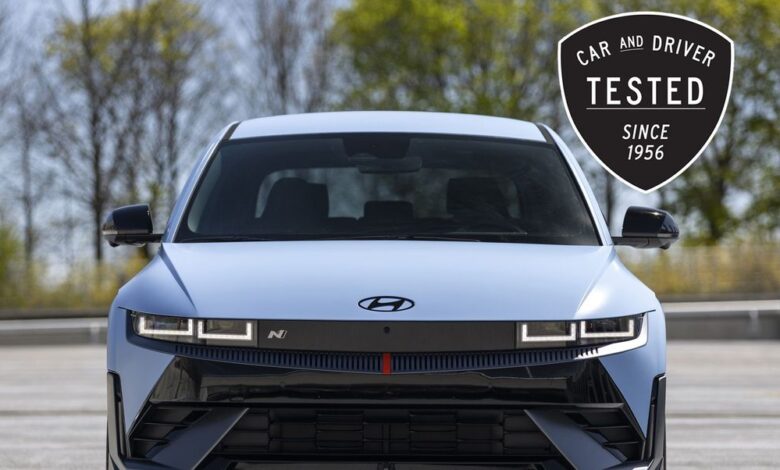Hyundai Ioniq 5 N Is the Quickest Korean Car We’ve Ever Tested

- The 2025 Hyundai Ioniq 5 N is the quickest Korean car we’ve ever tested, hitting 60 mph in 3.0 seconds flat.
- That time makes Hyundai’s 641-hp AWD EV a tenth of a second quicker than the Kia EV6 GT, and the N is 1.5 seconds quicker than the regular 320-hp dual-motor Ioniq 5.
- The Ioniq 5 N is also just as quick to 60 mph as the 2023 $128K Lucid Air Touring we tested previously, and it has an edge over the BMW i4 M50 and a Tesla Model 3 Performance.
Welcome to Car and Driver‘s Testing Hub, where we zoom in on the test numbers. We’ve been pushing vehicles to their limits since 1956 to provide objective data to bolster our subjective impressions (you can see how we test here).
Nothing sends a smartphone into airplane mode quite like the nutty acceleration of an electric vehicle. They’re heavy, but their viciously instant torque delivery and direct-drive transmissions make for some rapid speed. Best of all, a hot hatch such as the 2025 Hyundai Ioniq 5 N we just tested, accelerates like a six-figure sports car but at a fraction of the cost. Impressively, the $67K electric N’s 3.0-second rip to 60 mph is just three tenths of a second behind a 2022 Porsche 911 GT3 PDK. The last time a Hyundai put this much pressure on a Porsche, it was uninsured and tailgating someone on California’s 405.
The Korean King Is Quicker Than Others Too
For a short while, the 3.1-second 60-mph time of the speediest Kia EV6 GT we’ve tested earned it the crown as the quickest car from the Korean Hyundai/Kia group, but now that a high-performance trim has been added to the Ioniq 5 lineup this year, there’s a new king. The N blows the previously quickest Hyundai’s time out of the water, which was set by an Ioniq 6 with a 4.3-second 60-mph time. The track-focused 5 is also 1.5 seconds quicker than the more civilized 320-hp all-wheel-drive Ioniq 5 (4.5 seconds).
In N guise, the Ioniq 5 wears 275/35ZR-21 Pirelli P Zero PZ4 summer tires wrapped around 21-inch forged-aluminum wheels. Every N is all-wheel drive, and among its myriad drive settings, including its ability to mimic mechanical gearchanges while making fake Elantra N exhaust noise, torque can be split front to rear 11 different ways.
The quickest vehicle we’ve ever tested is the 2021 Ferrari SF90 Stradale, a 986-hp plug-in-hybrid rocket that completed its launch to 60 mph in 2.0 seconds. Owning such a capable machine will run you more than $700K, enough moola to buy each player on the first and second lines of the Pittsburgh Penguins an Ioniq 5 N—including the backup goalie.
While the Ferrari is quicker than every car we’ve tested, it might surprise you what EVs Hyundai’s 641-hp quasi-hatchback can beat to 60 mph. Because being the “quickest Hyundai” doesn’t sound too bragworthy, consider this context: the Ioniq 5 N is quicker to 60 mph than the BMW i4 M50 and Tesla Model 3 Performance and also just as quick to 60 as a 2023 Lucid Air Touring, with an as-tested price of $128k, that packs an extra 340 pound-feet of torque.
The N’s 11.1-second quarter-mile at 123 mph is impressive too. That beats any AMG-badged EV we’ve tested, and it’s a tenth behind the 834-hp Tesla Cybertruck Beast’s time of 11.0 seconds flat. Against our favorite gas-powered hot hatches, the much heavier Ioniq 5 N destroys their quarter-mile times: Honda Civic Type R (13.5 seconds at 106 mph), Toyota GR Corolla Morizo Edition (13.0 seconds at 106 mph), and the Volkswagen Golf R with a seven-speed dual-clutch automatic (12.6 ticks at 110 mph). Of course, Hyundai’s hardcore EV has roughly double the horsepower and costs more than all of them.
Big Stoppers and Solid Range to Boot
The quickest Korean car also has the biggest brakes ever used to stop a Hyundai. The 4849-pound Ioniq 5 N has 15.7-inch rotors up front, more than two inches larger than what’s used on Hyundai’s huge three-row Palisade SUV. From 70 mph, the Ioniq 5 stops in 153 feet. That’s just two feet shorter than the 5345-pound Lucid Air Sapphire (151 feet) which uses humongous 16.5-inch discs. Still, that puts the 5 N in good company with Lucid’s $250K EV. Against a vehicle in its segment, such as the 5001-pound Ford Mustang Mach-E GT Performance, the Ioniq 5 N stops five feet sooner from 70 mph and six feet sooner from 100 mph.
The Ioniq 5 N delivers mega performance for its price, but its driving range also isn’t as penalized as one might expect. During its 75-mph highway range test, the Ioniq 5 N made it 190 miles on a full charge, only 20 miles fewer than the 320-hp AWD Ioniq 5 we tested on the same loop. The N’s ability to quickly recharge fits its speedy persona too. In our DC fast-charge test, it took 35 minutes to recharge its 84.0-kWh battery from zero to 90 percent.
We can’t make any promises, but perhaps the Hyundai Ioniq 5 N has a few hearts left to break at our next annual Lightning Lap track event. The EV6 GT ran VIR’s 4.1-mile Grand Course with a 3:04.9. Hopefully, we get to find out.
Yes, he’s still working on the 1986 Nissan 300ZX Turbo project car he started in high school, and no, it’s not for sale yet. Austin Irwin was born and raised in Michigan, and, despite getting shelled by hockey pucks during a not-so-successful goaltending career through high school and college, still has all of his teeth. He loves cars from the 1980s and Bleu, his Great Pyrenees, and is an active member of the Buffalo Wild Wings community. When Austin isn’t working on his own cars, he’s likely on the side of the highway helping someone else fix theirs.



